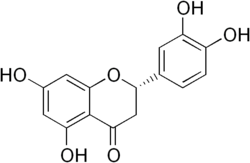- Eriodictyol
-
Eriodictyol 
Structure de l'eriodictyol. Général Nom IUPAC (2S)-2-(3,4-Dihydroxyphenyl)-5,7-dihydroxy-4-chromanone Synonymes Eriodictiol
3',4',5,7-TetrahydroxyflavanoneNo CAS No EINECS PubChem FEMA 4715 SMILES Apparence Solide blanc Propriétés chimiques Formule brute C15H12O6 [Isomères] Masse molaire[1] 288,2522 ± 0,0146 g·mol-1
C 62,5 %, H 4,2 %, O 33,3 %,Propriétés physiques T° fusion 257 °C[2] Solubilité Eau froide 0,07 g·l-1,
eau chaude 0,2 g·l-1[2]Composés apparentés Autres composés Stérubine, Homoeriodictyol Unités du SI & CNTP, sauf indication contraire. L'Eriodictyol est une flavanone (flavonoïde) extraite des feuilles de l'Herba Santa (Eriodictyon californicum)[3], une plante poussant dans le nord du Mexique et dans l'État de Californie[4].
Sommaire
Masqueur
La capacité de l'eriodictyol de réduire l'amertume de composé amer été mis en évidence par Symrise une entreprise de l'aromatique alimentaire. Dans cette même plante, 3 autres flavonoïdes ont été identifiés avec la même capacité à modifier le goût : la stérubine, l'homoeriodictyol et l'homoeriodictyol sodique[3].
L'eriodictyol a obtenu le statut Fema GRAS (numéro 4715) publié dans l'édition 25[5] et peut donc être utilisé dans les aliments en temps qu'arôme[6].
L'eriodictyol dosé à 20 ppm réduit de 40 à 60% la perception amère d'une solution contenant 0,5 g·l-1 de caféine[7]. Il est habituellement utilisé autour de 20 ppm et à un niveau maximum de 100pm pour la plupart des catégories alimentaire concernées et typiquement 50ppm avec un maximum de 250ppm pour les Chewing gum[5].
Autre source
L'eriodictyol a aussi été identifié dans d'autre végétaux comme le Millettia duchesnei[8] et l'Eupatorium arnottianum[9].
Un de ses hétéroside a été identifié dans l'églantier (Rosa canina)[10].
Notes et références de l'article
- Masse molaire calculée d’après Atomic weights of the elements 2007 sur www.chem.qmul.ac.uk.
- (en) SH Yalkowsky, Y He (2003) Handbook of Aqueous Solubility Data, Eriodytol. CRC Press, p993 (ISBN 0849315328)
- (en) Ley JP, Krammer G, Reinders G, Gatfield IL, Bertram HJ (2005) Evaluation of bitter masking flavanones from Herba Santa (Eriodictyon californicum (H. and A.) Torr., Hydrophyllaceae). J Agric Food Chem. 27;53(15):6061-6. PMID 16028996
- (en) Patricia Kaminski and Richard Katz. Yerba Santa Eriodictyon californicum. Flower Essence Society.
- (en) R.L. SMITH, S.M. COHEN, S. FUKUSHIMA, N.J. GOODERHAM, S.S. HECHT, L.J. MARNETT, P.S. PORTOGHESE, I.M.C.M. RIETJENS, AND W.J. WADDELL GRAS Flavoring Substances 25, FEMA 4667-4727 sur [1]
- (en) KRAMMER, G., LEY, J. & al. UTILISATION DE 4-HYDROXYDIHYDROCHALCONES ET DE LEURS SELS POUR ACCROÎTRE UNE IMPRESSION DE SUCROSITÉ Patent EP 1 998 636 B1, 19/05/2010
- (en) Jakob P. Ley. Masking Bitter Taste by Molecules. Chemosensory Perception, Volume 1, Number 1, 58-77, DOI:10.1007/s12078-008-9008-2
- (en) F Ngandeu, M Bezabih, D Ngamga, AT Tchinda, BT Ngadjui, BM Abegaz, H Dufat, F Tillequin (2007) Rotenoid derivatives and other constituents of the twigs of Millettia duchesnei. Phytochemistry. 2007 Jul 17. PMID 17640692
- (en) M Clavin, S Gorzalczany, A Macho, E Muñoz, G Ferraro, C Acevedo, V Martino (2007). Anti-inflammatory activity of flavonoids from Eupatorium arnottianum. J Ethnopharmacol. 2007 Jul 25;112(3):585-9. PMID 17570627
- (en) E Hvattum (2002). Determination of phenolic compounds in rose hip (Rosa canina) using liquid chromatography coupled to electrospray ionisation tandem mass spectrometry and diode-array detection. Rapid Commun Mass Spectrom. 2002;16(7):655-62. PMID 11921243
Voir aussi
Articles connexes
Liens et documents externes
- Portail de la chimie
- Portail de l’alimentation et de la gastronomie
- Portail de la biochimie
- Portail des odeurs, des senteurs et du parfum
Catégories :- Flavanone
- Benzènediol
- Modificateur de goût
- Arôme
Wikimedia Foundation. 2010.
